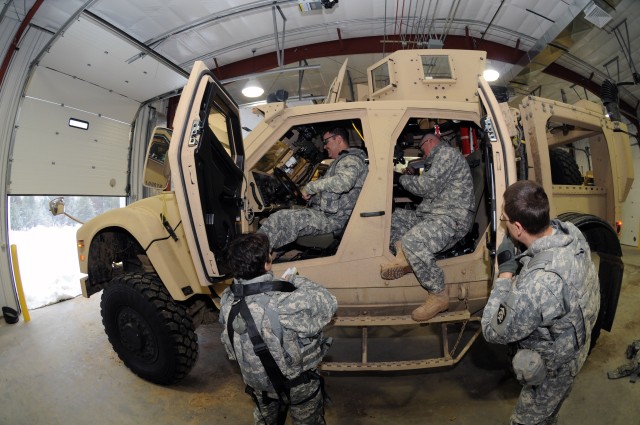
FORT McCOY, Wis. -- The mine-resistant, ambush-protected (MRAP) all-terrain vehicle (M-ATV), the newest member of the MRAP family, made its appearance on Fort McCoy's roads and off-roads, in recent months.
Mobilizing Soldiers successfully negotiated several miles of Fort McCoy's hilly and curvy tank trails through 14-inches of snow and ice with the new M-ATVs, according to Sgt. 1st Class Scott Ellsworth, master driver trainer with the 2/411th Logistics Support Battalion, 181st Infantry Brigade. Tire chains on the M-ATVs proved very effective.
"The M-ATV is designed to operate off-road on improved roads, unimproved roads, the dirt and sand trails like on Army installation tank trails, and dirt-and-gravel hard pack. There are almost no improved or paved roads in Afghanistan," Ellsworth said.
"Fort McCoy's trails are among the few such trails available at any mobilization station that replicate what U.S. forces will encounter in Afghanistan," Ellsworth said, referring to the winter conditions.
The M-ATV provides power when needed to overcome obstacles and traverse rough terrain, Ellsworth said. The new M-ATV helps stabilize the vehicle for off-road driving.
The M-ATV looks much like other vehicles in the MRAP family.
Differences are mostly in the gross vehicle weight and number of personnel carried on board. The M-ATV is the smallest in the MRAP family.
Each class of MRAP vehicle has different power plants, gross vehicle weights, and some carry up to 11 personnel, all depending on the mission purpose of the vehicle. Some are configured as ambulances to carry up to three litter patients. Others have differing levels of armor protection or carry different cargoes.
Other tactical combat vehicles with MRAP-like capabilities are the Buffalo mine-clearance vehicle and Husky mine-detection vehicle.
The MRAP design helps deflect explosive blasts.
"We trained 12 Soldiers on the M-ATVs from each of the engineer units (1249th, 877th and 649th) that mobilized at Fort McCoy," Ellsworth said.
"The MRAP driver training at Fort McCoy is very important because the Soldiers we certified can provide training to other personnel in their unit, in accordance with U.S. Army Forces Command and First Army MRAP training guidance," Ellsworth said.
"Those newly certified driver trainers can build a foundation and experience in their other Soldiers so, when they go outside the wire, outside the contingency operating locations, it won't be the first time the Soldiers get behind the wheel of the vehicle," Ellsworth said. "Driver's training is a journey, not a destination."
Part of MRAP driver training is PMCS, Preventative Maintenance Checks and Services, where vehicles are very thoroughly inspected before operation.
If a vehicle is not in good condition, attempts must be made to correct any discrepancies.
"PMCS absolutely must be performed," Ellsworth said. "Soldiers must take care of their vehicles."
Other aspects of driver training include using devices during periods of decreased visibility.
Driving also is performed in blackout conditions, operating in the dark with a "minimal directed light source," comparable to a small flashlight, and has been conducted by the military for decades.
"We train drivers in winch operation in order to pull themselves out of a difficult situation, vehicle towing operations and in vehicle rollover situations and rollover egress. We also do casualty-evacuation battle drills," Ellsworth said.

Social Sharing